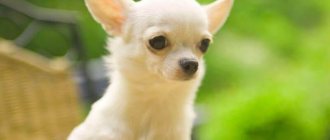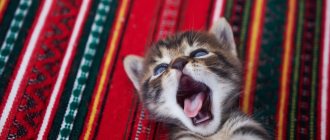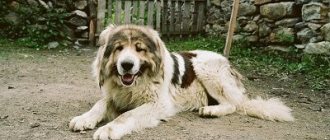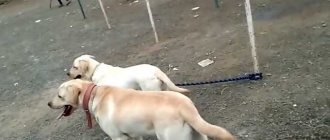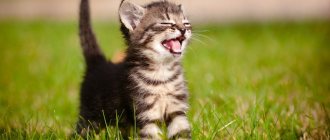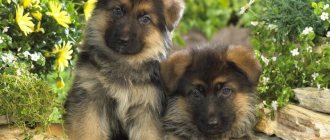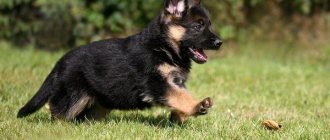Structural features
An adult shepherd dog should have forty-two molars in its mouth. Twenty teeth are on the upper jaw, twenty-two on the lower jaw.
A permanent tooth is a root embedded in the bone tissue of the jaw, which protrudes from the bone tissue of the neck and dental crown with strong enamel.
Dog teeth are divided into:
- incisors;
- fangs;
- premolars;
- molars.
Missing any tooth other than a small premolar is unacceptable.
Puppies have twenty-eight teeth. Deciduous incisors do not have roots. They are changed to permanent ones at the times indicated below.
Bite
The jaw model should be correct, scissor-shaped. The incisors of the upper jaw are located in front of the incisors of the lower jaw.
Next, we will describe milk teeth: when they begin to erupt and change to molars.
How many teeth does an adult shepherd have?
An adult pet has only 42 teeth. It is noteworthy that 22 of them are located on the lower jaw, and 20 on the upper jaw. The adult must have a scissor bite. Usually, by the age of 2 months, young dogs are formed correctly and have such a bite.
Important! Impaired development of the jaw is considered a defect. At the exhibition, such a dog will be rejected, regardless of its exterior and working qualities.
It happens that dogs, during training or specialized training, damage their teeth or lose them completely. In such a situation, it is possible to provide evidence of mechanical injury.
Evidence of mechanical damage may include:
- doctor's report with official seal;
- X-ray image.
Although many experts, despite a valid reason for the defect in the structure of the jaw, still reduce their estimates, believing that such animals cannot participate in breeding.
First changes
First, the German Shepherd's fangs begin to erupt, with two appearing in each jaw. Then come the incisors, then the premolars. Each jaw should have six incisors. There are cases when premolars erupt along with the incisors, or even earlier. In the absence of molars, premolars replace and fulfill their purpose. There should be six premolars in each jaw.
In summary, an excellent collection of baby teeth should look like this: fourteen teeth in each jaw. The absence of any cutter is unacceptable.
Primary incisors require the same care as primary incisors. The opinion that you should not pay any attention to them, since they will fall out in any case, is wrong. Their quality must be excellent.
When to contact a veterinarian
People go to the clinic for any problems with the change of teeth in a German Shepherd, when there is no confidence in their own abilities, experience and knowledge. If polyodontia is noted, the dentist will remove baby teeth, following certain rules:
- Only those milk teeth will be removed where the crown of the molar has appeared (usually after the removal of a temporary tooth, the permanent one takes its place);
- baby teeth are pulled out until the shepherd dog is 9 months old. In older animals, the occlusion altered by polyodontia is no longer restored;
- a tooth that splits during surgery is removed with roots and fragments;
- The removal of a baby tooth is completed by polishing the permanent one growing nearby, if plaque/tartar is found on it.
Important! When removing a baby tooth, there is a possibility of damaging the molar bud (if it has not yet erupted by this time), which can stop the growth of a permanent tooth in principle.
Surgical intervention is also indicated for hypodontia - the doctor makes an incision in the gum and periosteum to allow permanent teeth to emerge. Before the operation, an x-ray examination is prescribed to establish the position/condition of the permanent tooth germ.
Surgical manipulations in the dog’s oral cavity are performed using general/local anesthesia, as well as using sedatives. Of course, painkillers have a negative effect on the dog’s body, but you cannot do without them when cutting the periosteum or removing teeth. Anesthesia protects the animal from pain and allows you to undergo the operation without stress.
How it all happens
Baby teeth begin to change at three months. Be prepared for this period and be patient. This complex process can cause fever and malaise. While they are changing, surround your baby with care and attention. Avoid long walks outside, as your pet may be weak and sleepy, and a long hike will only make him tired. And remember - no stress.
How to help your baby
It’s better to let your German Shepherd puppy chew on a bone or a rubber ball, they will help in this difficult task. You should not pull these objects while playing, taking them away from the puppy - you can ruin the bite.
When changing teeth, do not forget about the feeding regimen and ensure that the composition of the mineral supplement remains unchanged. Give your puppy marrow bones, they will help the proper formation of molars.
If you notice that a tooth is loose, then feel free to pull it out, but only if you don’t need to apply any special force. Strongly standing fangs should not be pulled out yourself, as fragments may remain. To avoid accidentally hurting your German Shepherd puppy, gently pull the tooth to the side. Or just wait until the teeth fall out on their own.
Shift order
First, the incisors begin to change. And when the puppy turns four months old, the canine teeth will begin to change.
There are times when you have to use forceps and have surgery to remove primary fangs, as they can interfere with the natural germination of primary ones. Don't worry about the puppy, he will easily endure this process.
The replacement of baby teeth stops around ten months and twenty-eight baby teeth are completely replaced by forty-two molars.
Does this process depend on the breed of dog?
Typically, experienced breeders pay quite a lot of attention to the timing and with what nuances of teeth changing in puppies. As a result of long-term observations, it was noticed that in almost all representatives of decorative and dwarf dogs this process begins with a slight lag. From this we can conclude that the timing of dentition change directly depends on the breed of the animal.
For greater clarity, you can understand this issue in detail using the example of how teeth change in Chihuahua puppies. They have a small mass and belong to the dwarf breeds. In small animals there is often a delay in the eruption of permanent teeth. During this period, it is extremely important to ensure that the Chihuahua does not develop two rows of incisors. To avoid possible dental problems, you need to show your dog to the veterinarian in a timely manner.
In recent years, there has been a very steady trend towards an increase in cases of dentition disturbances in representatives of large breeds, including Labradors, Rottweilers, Boxers, Dobermans, East European and German Shepherds. Most often, veterinarians have to deal with a temporary delay in the change of teeth, in which complete loss of baby teeth occurs only by the age of one year.
Proper care
For natural cleaning of fangs, crackers or suitable bones are perfect. Also for this purpose, give your pet tomatoes, apples, and raw carrots.
Once a week, brush your German Shepherd's teeth with a special brush and toothpaste.
If you notice plaque or stone during the examination, then consult a doctor, he will help remove excess from the German Shepherd’s mouth.
How to help a puppy with teeth changes
During this period, you need to show more attention and care towards your pet. When puppies are teething, they need to constantly chew on something. Therefore, the owner should make sure that the dog has something to chew. To prevent the appearance of inflammation or other abnormalities in the formation of grins.
Massaging the gums with a soft silicone brush is useful. It wouldn't hurt to buy special toys. If you have any alarming symptoms, you should contact your veterinarian.
The puppy may not allow you to examine the oral cavity
Occurrence of violations
If the rudiments of the incisors and the process of eruption of milk teeth depend entirely on genetic heredity, then the dog owner is responsible for the successful change of teeth.
The future of the canines depends on the conditions of care, maintenance and diet of the German Shepherd. Any violations will lead to bad consequences.
Late shift
The reason for the late change of teeth can be poor development of the jaw muscles when food that is too loose is used in the feeding regime. A reduction in meal times also leads to changes.
If a dog has a genetic predisposition, then with poor care, the load on the jaws decreases. Accordingly, a change of fangs will not happen without outside intervention.
Due to the late change of teeth, the molars become displaced, which leads to jaw injury.
In case of delay
If the change of baby teeth does not occur on time, the German Shepherd acquires an incorrect bite. As a result, after feeding, pieces of food remain in the spaces between the molars, thereby forming plaque, stone, and caries.
There are several bite changes:
- undershot;
- snack;
- compensated undershot.
Let's take a closer look at bite defects.
An underbite is the gap between the incisors of the lower and upper jaws. When the lower jaw lags behind in development, molars have to be removed, otherwise they can injure the gums. But even after the necessary removal, the dog can eat as usual.
When overbiting, the incisors of the upper jaw stand behind the incisors of the lower jaw.
A compensated underbite looks like a slightly shortened lower jaw with a slight horizontal inclination of the incisors.
Disturbances in the growth of molars
Due to infectious diseases, enamel deteriorates. It becomes thinner and uneven, pitted, and absent in some places.
If the puppy chews on too hard objects while the teeth are growing, the crown will crack.
Do I need to adjust my diet?
Often the cause of malocclusion is precisely feeding errors. Experts are convinced that food rich in minerals/vitamins (during the period of teeth change) is capable of correcting a malocclusion in 50% of cases, and the final conclusion about underbite or overbite is made after all teeth have been replaced.
Puppies receiving natural food or economy food are given mineral supplements with calcium, fluorine and phosphorus. A lack of calcium (as well as its excess) can provoke allergic manifestations or cause diseases of the musculoskeletal system. German Shepherds that eat dry diets labeled “holistic” and “super-premium” do not need such bait.
Important! Veterinarians mention another key factor that leads not only to all sorts of problems with changing teeth, but also to other deviations and even diseases of the dental system - this is a reduction in feeding time.
If previously at least 20–30 minutes were allotted for eating, now this interval has narrowed to 5–10 minutes, which significantly reduces the load on the dentofacial apparatus. In addition, dog breeders should remember that when changing teeth, the puppy is given large teeth that promote the growth, straightening and strengthening of permanent teeth.
Return to content
Dog mouth diseases
With insufficient care and poor maintenance, the German Shepherd's teeth can be affected by various diseases. As a result, health deteriorates and a bad smell appears from the pet’s mouth. To avoid this, you should visit a veterinarian in a timely manner for preventive maintenance.
There are several types of German Shepherd mouth diseases.
Cheilitis is inflammation of the lips, gingivitis is inflammation of the gums, stomatitis is inflammation of the oral cavity. These diseases are the result of bacteria, fungi and viruses. The presence of the disease is determined by the formation of plaque on the mucous membrane and a bad odor from the animal’s mouth.
Caries is the gradual destruction of the incisor, periodontitis is inflammation around the tooth, periodontal disease is damage to the bone part of the periodontium. These diseases develop as a result of the appearance of plaque and tartar on the dog's teeth. All this will lead to the loss of molars.
Pulpitis is an inflammation of the dental pulp after damage by caries. The dog may refuse to eat due to severe pain.
Polydontia – multiple teeth.
Prevention
Changing teeth is a very important period, and it is worth constantly monitoring the condition of the jaw. Check your incisors at least twice a week.
Let's give some tips so that you can prevent any violations:
First, don't let your puppy chew sticks or furniture.
Secondly, when changing teeth, be careful with the choice of game - you cannot pull an object out of your jaw.
Thirdly, from three to five months, refuse vaccination. This is the most restless period for changing incisors.
If your puppy eats dry food, do not add anything to his diet to avoid overdosing. If your pet eats natural foods, then add fish oil, brewer's yeast, fluoride, ascorbic acid, and sea buckthorn oil to the diet.
In the absence of genetic inheritance and proper care, the process of changing baby teeth will go quickly and without any problems. Follow the above tips and everything will be fine.
Did you like the article? How do your puppy's teeth change?
What can you chew to relieve itchy gums?
During the period of teeth change, most owners, through their own carelessness, lose valuable things - shoes, headphones, notebooks and even phones. Furniture, floor coverings, door jambs, etc. are often damaged. How to prevent a “catastrophe”.
What can you give your puppy to chew to relieve discomfort:
- Durable toys - so that the baby does not get bored with the same objects, they can be changed every 2-3 days.
- Teethers are durable, specially shaped toys. The advantage of teethers is that they are safe; even if the puppy bites off a piece of the toy and swallows it, nothing will happen.
- Chewable treats (bones, sticks).
- Large articular bones (moslaks) with meat, spongy bones, raw and boiled cartilage.
- Raw vegetables and fruits.
- Wood, dry, preferably from fruit trees.
The best option to interest the puppy and teach him to chew only permitted objects is special treats and toys.
Bones are a good option if the puppy is in plain sight, but needs something to keep him occupied. Vegetables and fruits are the most useful toy. The puppy receives vitamins, coarse fibers and is accustomed to healthy food.
